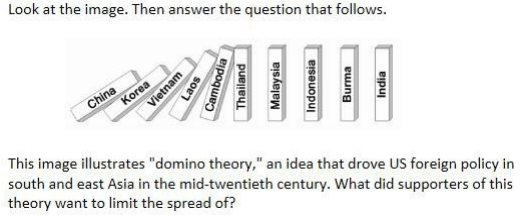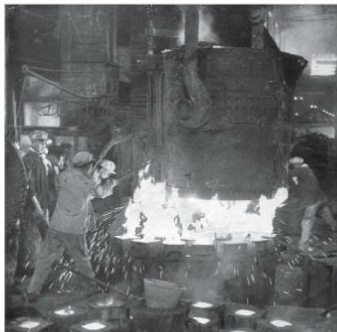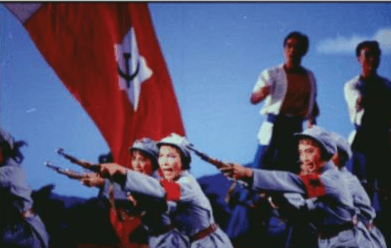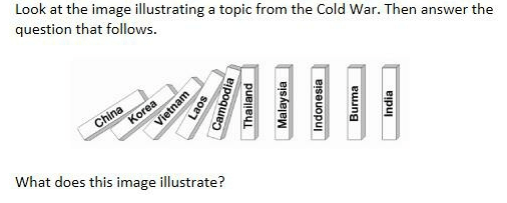What contributed to the growth of nationalism in India?
A. The country's occupation by China
B. The country's occupation by Great Britain
C. The spread of Christianity in the country
D. The spread of Buddhism in the country
B. The country's occupation by Great Britain
Mohandas Gandhi promoted which means to Indian independence?
A. violent overthrow
B. nonviolent resistance
C. economic sovereignty
D. international pressure
B. Nonviolent resistance
Which of the following helped Japan's economy recover following World War II?
A. Soviet humanitarian and military aid
B. the discovery of oil and coal reserves
C. significant investment by the United States
D. the economic programs of the Marshall Plan

A. disease
B. communism
C. terrorist activity
D. economic depression
B. Communism
Anu was born and raised in India. It is MOST LIKELY that Anu practices which religion?
A. Shintoism
B. Confucianism
C. Hinduism
D. Taoism
C. Hinduism
Which conflict drained Great Britain's resources and made it difficult for it to maintain control of India?
A. World War I
B. the Cold War
C. World War II
D. the Gulf War
C. World War II
The Indian National Congress, led by Mohandas Gandhi, and the Muslim League both fought for
A. Indian rights and independence.
B. the creation of an Indian theocracy.
C. the establishment of an official Indian religion.
D. equal status in a commonwealth with Great Britain.
A. Indian rights and independence
Which statement best compares North and South Korean governments after the Korean War?
A. North Korea is communist, South Korea is democratic
B. North Korea is monarchy, South Korea is communist
C. North Korea is communist, South Korea is monarchy
D. North Korea is democratic, South Korea is monarchy
A. North Korea is communist, South Korea democratic
Look at the image from China during the Great Leap Forward. Based on the photograph, and your knowledge what was the ultimate goal of Mao Zedong Great Leap Forward?

A. to rapidly industrialize the Chinese economy
B. to replicate the Soviet economic model in China
C. to improve working conditions in Chinese factories
D. to rebuild the infrastructure of China after World War II
A. To rapidly industrialize the Chinese economy
In Hinduism, the moral law of the universe that directs the cycle of rebirth is called
A. karma.
B. reincarnation.
C. kami.
D. dharma
A. Karma
Why did India continue to struggle after gaining its independence in 1947?
A. The country had access to very few valuable natural resources.
B. The United Kingdom's allies refused to trade with the country.
C. There was conflict between its Hindu and Muslim populations.
D. China pressured the government into adopting communist reforms.
C. There was conflict between its Hindu and Muslim populations.
Mohandas Gandhi advocated for an India characterized by
A. Hindu principles and ancient crafts.
B. economic and technological power.
C. political independence and religious pluralism.
D. membership in the British Commonwealth of Nations.
C. Political independence and religious pluralism
Which of the following was NOT part of US efforts to control and rebuild Japan after World War II?
A. Education and literacy increased across Japan.
B. The United States ended the reign of the Japanese monarchy.
C. Foreign nations assisted in building new and improved factories in Japan.
D. The United States wrote a new Japanese constitution outlawing aggression.
B. The United States ended the reign of the Japanese monarchy.
Look at this play about the Chinese Cultural Revolution. Based on the image and your knowledge, what was the goal of the Cultural Revolution?

A. to begin the industrialization of China
B. to promote the ideology of Joseph Stalin
C. to maintain the ideology of Mao Zedong
D. to celebrate the traditional culture of China
C. To maintain the ideology of Mao Zedong
A Shintoist would be MOST LIKELY to
A. pray five times each day.
B. make a pilgrimage to Rome.
C. attempt to rid himself of karma.
D. visit a shrine near a peaceful stream.
D. Visit a shrine near a peaceful stream
The "Salt March" of 1930 was a key moment in the independence movement of people in what country?
A. Cuba
B. Ethiopia
C. India
D. Vietnam
C. India
Mahatma Gandhi was a leader in the movement for Indian independence who advocated the use of which of the following methods of opposition to colonial rule?
A. civil war
B. coup d'état
C. guerrilla warfare
D. nonviolent protest
D. Nonviolent protest
Which of the following played the largest role in Japan's economic recovery in the 1950s?
A. adoption of the General Agreement on Tariffs and Trade
B. humanitarian assistance from members of the Warsaw Pact
C. the interventionist economic policies of the Japanese government
D. efforts by the United States to encourage foreign direct investment
C. Interventionist economic policies of the Japanese government
During the rule of Mao Zedong, which group was known for breaking into the homes of people they considered bourgeois and destroying artworks, antiquities, and genealogical records?
A. the Red Guards
B. the Gang of Four
C. the Five Man Group
D. the Cultural Revolution Group
A. The Red Guards
In Japan, flower arranging and tea ceremonies BEST reflect the influence of
A. karma.
B. Hinduism.
C. Shintoism.
D. reincarnation.
C. Shintoism
Who was this leader of India often associated with acts of nonviolent resistance?
Mohandas Gandhi
Both Mohandas Gandhi and Mao Zedong
A. Appealed to the common people for support
B. Believed in non-violent political movements
C. Desired democratic reforms with capitalist economies
D. Led revolutionary movements against the British Empire
A. Appealed to the common people for support
What promise did Japan make after ratifying its new constitution following World War II?
A. to only trade with the United States and its allies B. to abolish the title of emperor and its monarchy
C. to pay reparations to the nations it harmed in the war
D. to maintain close alliances with socialist governments
C. To pay reparations to the nations it harmed in the war

A. the impact of international terrorism on the world
B. the justification for US military involvement in Asia
C. the justification for signing arms reduction treaties
D. the impact of a severe economic depression on Asia
B. The justification for US military involvement in Asia
What religion spread first from China to Korea, and then to Japan, where it influenced the nation's traditional Shinto practices?
A. Taoism
B. Sikhism
C. Buddhism
D. Confucianism
D. Confucianism